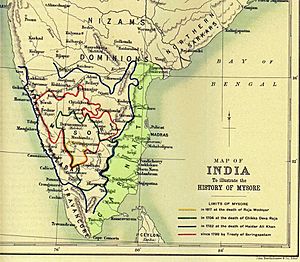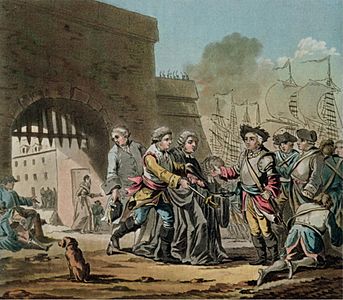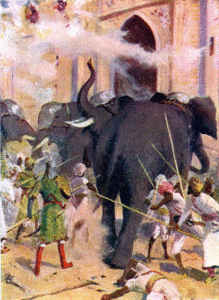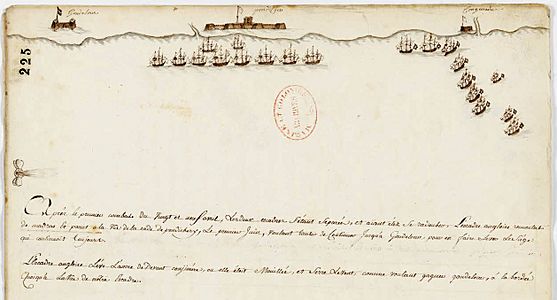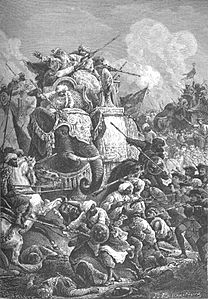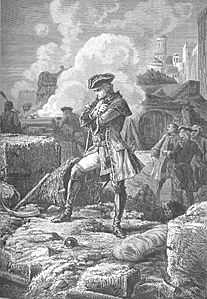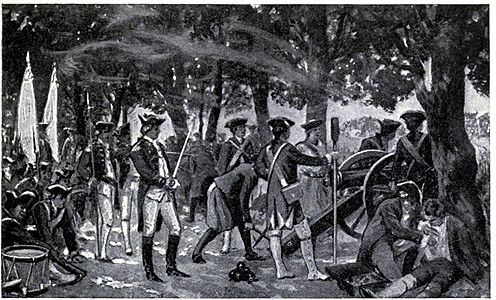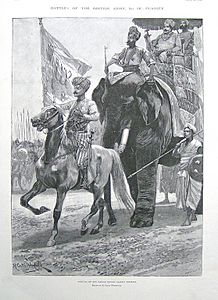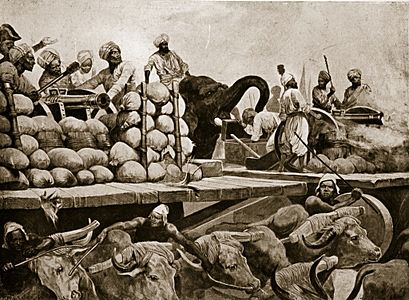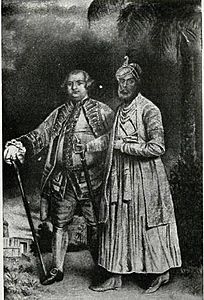Carnatic wars facts for kids
Quick facts for kids Carnatic wars |
||||||||
|---|---|---|---|---|---|---|---|---|
| Part of the Decline of the Mughal Empire, Anglo-French wars and the Anglo-Indian wars | ||||||||
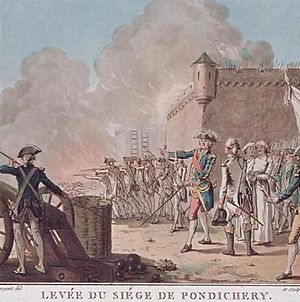 End of the siege of Pondicherry in 1748. |
||||||||
|
||||||||
| Belligerents | ||||||||
|
||||||||
| Commanders and leaders | ||||||||
|
|
|||||||
The Carnatic Wars were a series of big fights in India during the mid-1700s. They happened in a coastal area called the Carnatic region. These wars were mainly between the French East India Company and the British East India Company. Both companies wanted to control trade and power in India. Many local Indian rulers also joined in, taking sides with either the French or the British. The first Carnatic War took place between 1740 and 1748.
These conflicts involved many rulers who were almost independent. There were also struggles over who would rule next and who owned certain lands. The French and British companies fought both with diplomacy and military force. Most of these battles happened in areas that were part of Mughal India. In the end, the British East India Company won. This made them the most powerful European trading company in India. The French company lost much of its influence. This British victory eventually led to the British Raj, where Britain controlled most of India.
Contents
Why the Wars Started
The Mughal Empire started to weaken after Emperor Aurangzeb died in 1707. Different parts of the empire became more independent. One such area was Hyderabad State, led by Nizam-ul-Mulk. After he died, his son, Nasir Jung, and grandson, Muzaffar Jung, fought over who would rule. Foreign powers like France and Britain quickly got involved. France supported Muzaffar Jung, while Britain helped Nasir Jung.
The Carnatic region was another area that became somewhat independent. It was ruled by Nawab Dost Ali Khan, even though it was legally part of Hyderabad. When Dost Ali Khan died, his son-in-law, Chanda Sahib, and Muhammad Ali fought for control. The French supported Chanda Sahib, and the British supported Muhammad Ali.
A key person who started these wars was Joseph François Dupleix. He arrived in India in 1715 and became the French East India Company's governor in 1742. Dupleix wanted to make France more powerful in India. At first, France only had a few trading posts, like Pondicherry. Dupleix began training Indian soldiers under French officers. He also made deals with local rulers to increase French influence. But he met a strong opponent in Robert Clive, a young British officer.
Wars in Europe also caused fighting in India. For example, the War of the Austrian Succession in 1740 and the Seven Years' War in 1756 led to conflicts between the French and British in India.
First Carnatic War (1746–1748)
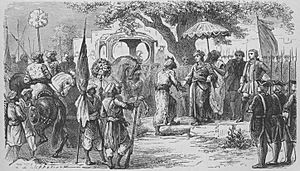
The War of the Austrian Succession started in Europe in 1740. Great Britain joined the war against France and its allies in 1744. Even though their home countries were fighting, the French and British trading companies in India were friendly at first. They even helped each other store goods safely.
However, the British were told that their navy was coming to India. After the British captured some French trading ships, the French called for help from Mauritius. This led to more warships arriving in the area. In July 1746, French commander La Bourdonnais and British Admiral Edward Peyton had a sea battle that didn't have a clear winner. After this, the British fleet left.
On September 21, 1746, the French captured the British trading post at Madras. La Bourdonnais had promised to give Madras back to the British. But Joseph François Dupleix changed this plan. He wanted to give Madras to Anwar-ud-din, the Nawab. The Nawab then sent a large army of 10,000 men to take Madras from the French. But a small French force easily defeated them in the Battle of Adyar.
The French then tried to capture the British Fort St. David at Cuddalore several times. But British reinforcements arrived in time and stopped them. Later, British Admiral Edward Boscawen attacked Pondicherry in late 1748. But he had to stop the attack when the monsoon rains began in October.
The First Carnatic War ended when the War of the Austrian Succession ended in Europe. In the Treaty of Aix-la-Chapelle (1748), Madras was given back to the British. In return, the French got back their Louisbourg fortress in North America, which the British had captured. This war was important because it was the first military experience for Robert Clive. He was captured at Madras but escaped. He then helped defend Cuddalore and attack Pondicherry.
Second Carnatic War (1749–1754)
Even though there was no official war in Europe, the fighting continued in India. This was like a "proxy war," where the main countries fought through others. On one side was Nasir Jung, the Nizam of Hyderabad, and his ally Muhammad Ali. The British supported them. On the other side were Chanda Sahib and Muzaffar Jung, who were supported by the French. They were fighting to become the Nawab of Arcot.
Muzaffar Jung and Chanda Sahib managed to capture Arcot. When Nasir Jung died, Muzaffar Jung became the ruler of Hyderabad. But Muzaffar's rule was short, as he was soon killed. Salabat Jung then became the Nizam. In 1751, Robert Clive led British troops to capture Arcot. He then successfully defended it during a siege. The war ended with the Treaty of Pondicherry in 1754. This treaty recognized Muhammad Ali Khan Walajah as the Nawab of the Carnatic. Charles Godeheu replaced Dupleix as the French governor. Dupleix later died poor in France.
Third Carnatic War (1757–1763)
The Seven Years' War began in Europe in 1756. This led to more fighting between French and British forces in India. At this time, the French were having many money problems. The Third Carnatic War spread beyond southern India to Bengal. There, British forces captured the French settlement of Chandernagore in 1757.
However, the main battles happened in the south. The British successfully defended Madras from a French siege. Sir Eyre Coote then strongly defeated the French, led by the Comte de Lally, at the Battle of Wandiwash in 1760. After this battle, Pondicherry fell to the British in 1761.
What Happened Next
The war officially ended with the Treaty of Paris (1763). This treaty gave Chandernagore and Pondicherry back to France. It also allowed the French to have trading posts in India. However, French traders were not allowed to control these areas. The French agreed to support British-backed local governments. This ended France's dreams of having an empire in India. It made the British the most powerful foreign force in India.
Gallery
-
The Siege of Arcot (1751) was a major battle fought between Robert Clive and the combined forces of the Mughal Empire's Nawab of the Carnatic, Chanda Sahib, assisted by a small number of troops from the French East India Company
-
Robert Clive fires a cannon in the Siege of Arcot.
-
French and English boats position near Pondicherry. French National Archives.
-
Lally at Pondicherry.
-
The Black Hole of Calcutta, 20 June 1756.
-
Jean Law's Memoire: Mémoires sur quelques affaires de l'Empire Mogol 1756–1761 contains detailed information about the campaign of the Mughal Emperor Shah Alam II and his French allies against the British East India Company.
-
Nawab of Bengal, Mir Qasim at the Battle of Buxar
-
Mughal artillerymen at Plassey during the Carnatic wars.
See also
- French India
- Salabat Jung
- Hyder Ali
- Anwaruddin Khan


